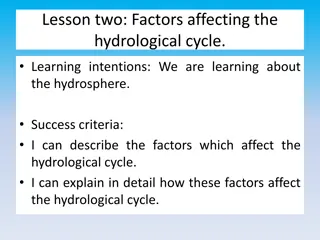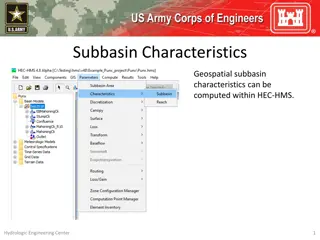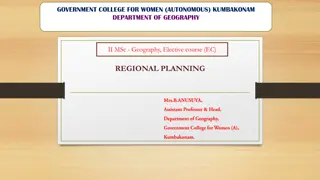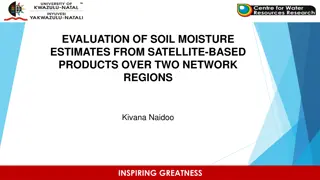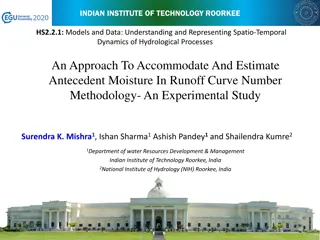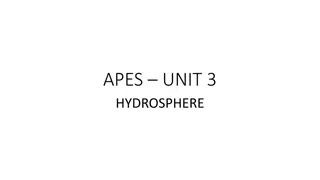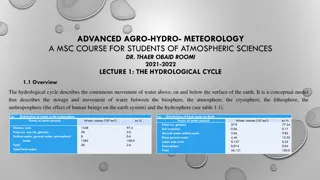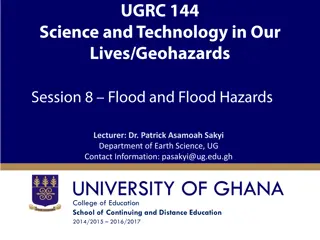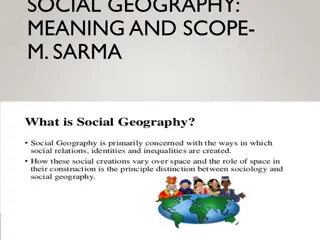Understanding the Hydrological Cycle in Geography Education
Delve into the intricacies of the hydrological cycle within the hydrosphere, learning about the processes, factors, and impacts associated with water movement in urban and rural areas. Explore the concept of hydrology, drainage basins, hydrographs, and the water cycle powered by the sun. Enhance your knowledge through interactive tasks, assessments, and diagrams to master this essential geographical topic.
Download Presentation

Please find below an Image/Link to download the presentation.
The content on the website is provided AS IS for your information and personal use only. It may not be sold, licensed, or shared on other websites without obtaining consent from the author. Download presentation by click this link. If you encounter any issues during the download, it is possible that the publisher has removed the file from their server.
E N D
Presentation Transcript
Hydrosphere Higher Geography
Assessment What you must know Explain hydrological cycle Explain how hydrological cycle Account for drainage basin Explain and hydrographs factors can affect the water movement within a compare urban and rural
Homework Page 1 of booklet. All homework must be handed in on lined paper. Remember to put your name on it.
Lesson one: The Hydrological Cycle Learning intentions: We are learning about the hydrological cycle. Success criteria: I can draw an annotated diagram of the hydrological cycle. I can explain the hydrological cycle.
What is hydrology? Hydrology is the study of water within the Earth, whether atmosphere, on underground. The movement of impact of it on the land and how movement may be interrupted are also important aspects of this particular topic. it is in the or the surface that water, the
Starter Group task 1. What powers the hydrological cycle? 2. What processes take place there? 3. Where does water go when it rains? 4. How does it return back into the atmosphere?
The hydrological cycle The intricate process of movement of water back and forth between land, oceans and the atmosphere is called the hydrological cycle. The hydrological cycle system, in that there is a finite amount of water in the atmosphere, hydrosphere (land and water areas). amount remains constant. The system is powered by energy from the Sun. Within the system the amount of water in the various components especially when the system is interrupted. works as a closed lithosphere and This can and does vary,
What you need to know You should be able to draw a diagram to show the hydrological cycle and explain the main elements within the diagram. In your exam, you may be given a diagram of the hydrological cycle or asked to draw this yourself. See page 3 of your booklet now.
The hydrological cycle The hydrological cycle is powered by the sun. When the sun shines, water in the sea is evaporated this means the water is heated and rises into the atmosphere. As it does, it turns from a liquid into a gas in the form of water vapour.
The hydrological cycle As this water vapour is rising, it cools and condenses to form clouds. The wind then blows these clouds over land or sea which is called advection which is a form of transportation.
The hydrological cycle When the clouds become saturated with water vapour, the clouds release the water vapour in the form of a liquid (or solid). This is known as precipitation and can be in the form of rain, hail, sleet or snow.
The hydrological cycle Where does this precipitation go? Firstly it can go straight into soil. It enters the soil vertically through infiltration. It then percolates downwards through the soil through the pore spaces in the rocks.
The hydrological cycle Ground water It then moves through the soil with gravity towards a river or the sea. This is called throughflow. It can however be stored in the pore spaces in the rocks called ground water. The pore spaces can become totally saturated with water. The level at which they do this is called the water table.
The hydrological cycle Absorption Ground water Secondly, the water can be stored in plants. Plant leaves can draw the water upwards through absorption and can then return the water to the atmosphere by transpiration where water is lost through the pores on the leaves.
The hydrological cycle Interception Absorption Stem flow Ground water Precipitation can fall directly on the plant leaves before reaching the ground (interception) but it can make its way to the soil by stem flow where water runs drips from the leaves or runs down the trunk where it can then infiltrate the soil.
The hydrological cycle Channel flow Interception Absorption Stem flow Ground water Lastly, precipitation can fall directly into lakes or the sea and be stored there, or it can flow over the surface of the land (overland flow/surface run off ), and can then collect in river and flow to the ocean as channel flow.
The water table The water table marks the level where the ground is saturated. After heavy rainfall, you can sometimes see the water table come to the surface.
Task Watch how water moves through the hydrological cycle. The Hydrological Cycle Task 1 Explain the global hydrological cycle. You may wish to draw an annotated diagram. (6)
Perfect answer Water is heated by the sun and turns to a vapour. This evaporates into the atmosphere. When the vapour gets high into the atmosphere it cools and condenses, forming clouds. Clouds are moved, overland, by the process of advection. When clouds become saturated with moisture it pulled to earth by gravity. This is called precipitation and can be rain, hail, sleet or snow. The precipitation may be stored or transferred back to the river/ocean in a number of ways.
Perfect answer The water may be stored in a lake or as ice or snow on an area of high land. Precipitation may fall directly onto the soil. It can infiltrate the soil and make its way back to the river by the process of throughflow. It may percolate through the soil until it reaches an area of impermeable rock. The water will fill up groundwater stores. This is called the watertable. Water is then transferred back to the river or ocean by the process of groundwater flow.
Perfect answer Precipitation may fall onto vegetation. It can be transpired off of leaves back into the atmosphere, this is evapotranspiration It may trickle down the stems of plants into the soil, this is called stem flow. Water may be absorbed from the soil by plants and then evaporated off of their leaves, back into the atmosphere. Some precipitation will flow directly overland, back to the river, by the process of surface run- off. Some will fall directly into the river and flow back to the ocean as channel flow
Success criteria I can draw an annotated diagram of the hydrological cycle. I can explain the hydrological cycle.
Plenary Water cycle rap




